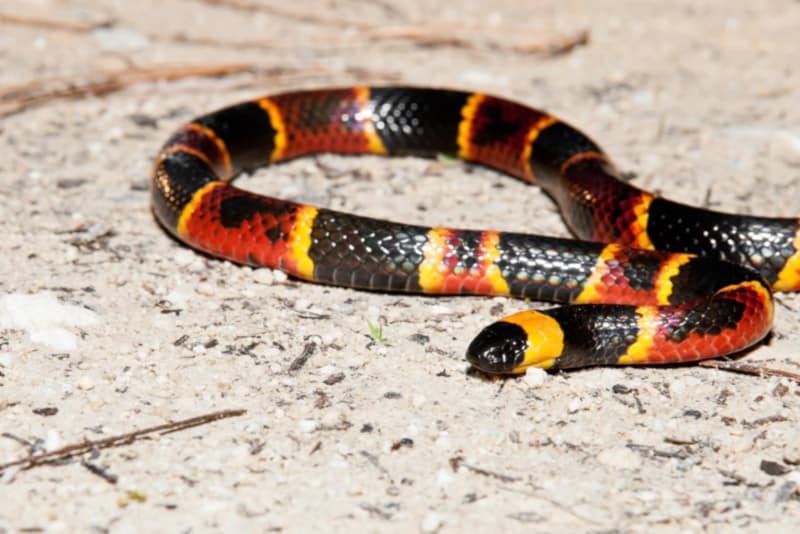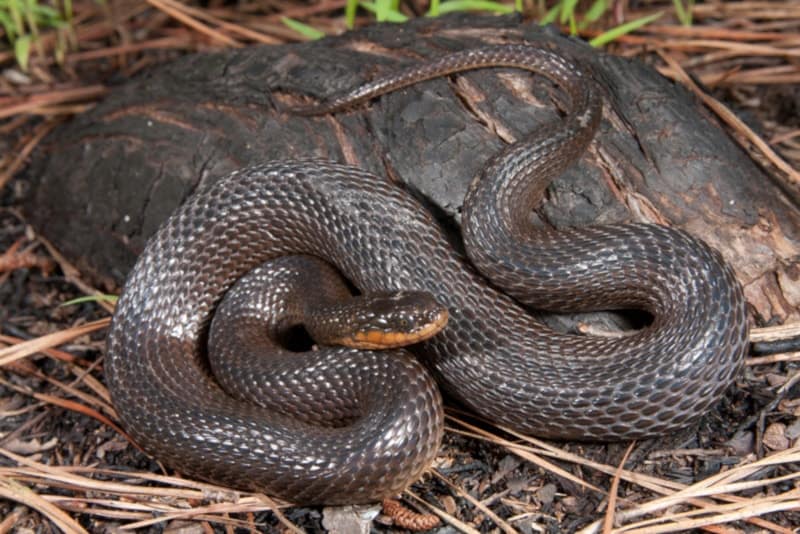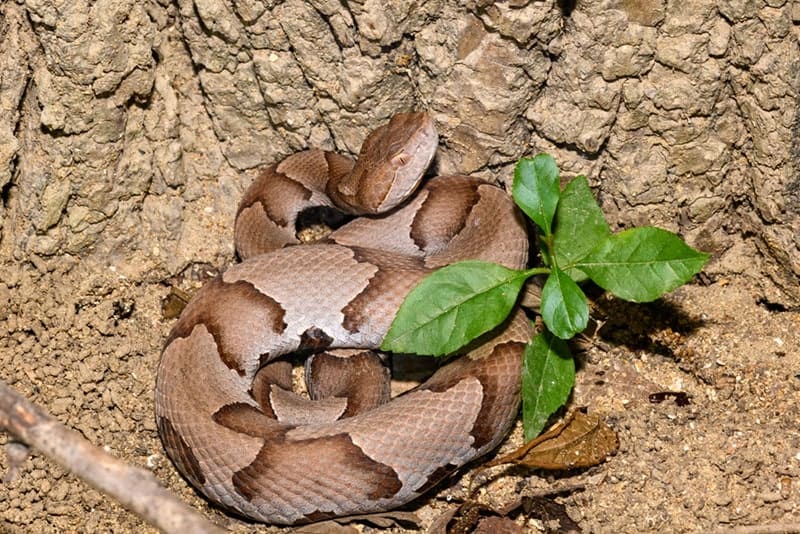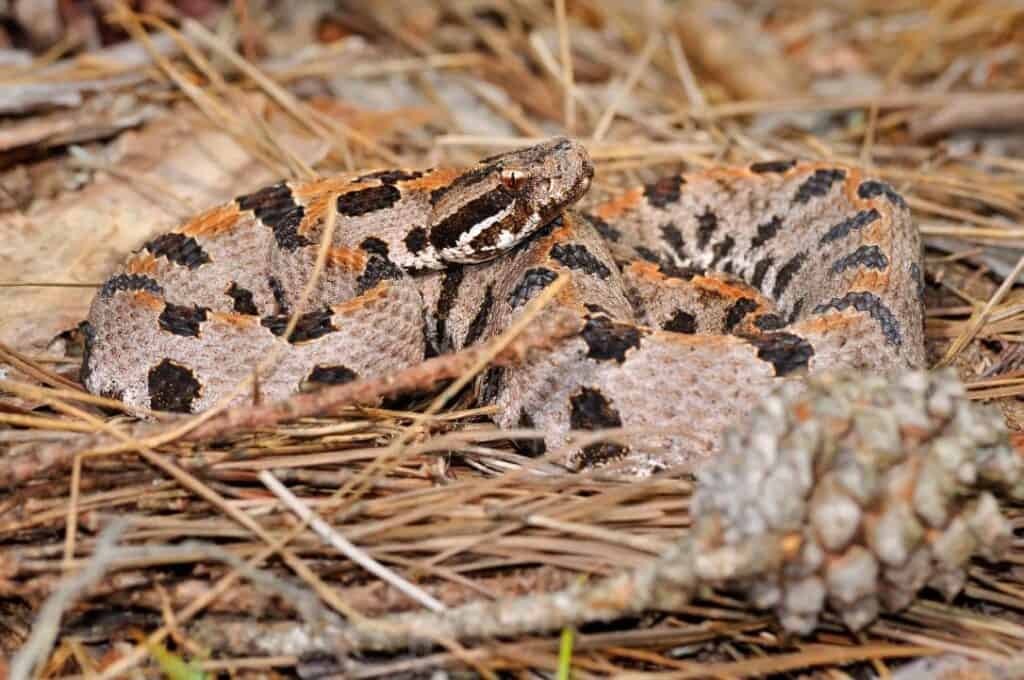Florida is the state for you if you’re looking to encounter a diverse selection of snakes and reptiles. This southern region is home to over 44 native snake species, with only six of those being venomous. It doesn’t matter that you’re in the dry uplands, coastal mangroves, or saltmarshes. If you’re in Florida, you’re never too far from some sort of snake.
Florida is a valuable ecosystem for snakes and vice versa. Snakes help to reduce the high rodent population, which in turn saves crops from being destroyed or carrying diseases that spread to humans. Surprisingly enough, even the non-venomous snakes eat the venomous ones and keep the entire ecosystem in balance.

The 10 Snakes Found in Florida
1. North American Racer

| Species: | Coluber constrictor |
| Longevity: | 6 – 10 years |
| Good to own as a pet?: | No |
| Legal to own?: | Yes |
| Adult size: | 20 – 56 inches |
| Diet: | Carnivorous |
The North American Racer snake is one that is commonly found in most parts of North America. They reach large sizes of up to 56 inches long and most adults are black or bluish in color with white marks around their chin and throat. The younger snakes have reddish-orange blotches that run down their body. These snakes are non-venomous and not typically dangerous to people or pets unless defending themselves. They feed on a range of animals like birds, eggs, lizards, turtles, snakes, fish, insects, and small mammals. They overpower their prey by grabbing them with their strong jaws and pinning them to the ground until they are ready to swallow them alive.
2. Red Corn Snake

| Species: | Pantherophis guttatus |
| Longevity: | 6 – 8 years |
| Good to own as a pet?: | Yes |
| Legal to own?: | Yes |
| Adult size: | 30 – 48 inches |
| Diet: | Carnivorous |
Also called the chicken snake, red rat snake, and easter corn snake, this snake species is interesting to look at with their orange and brown bodies with blotches with black borders along their entire head and back. These non-venomous snakes are not very aggressive and shy away from humans when they see them. Red Corn snakes are usually found in swamps, agricultural fields, and pinelands. Some of them live in suburban areas as well. They coil their bodies around their small prey before they consume them.
3. Eastern Diamond-backed Rattlesnake

| Species: | Crotalus adamanteus |
| Longevity: | 15 – 20 years |
| Good to own as a pet?: | No |
| Legal to own?: | Yes |
| Adult size: | 33 – 72 inches |
| Diet: | Carnivorous |
The venomous snakes in Florida that you’re most likely to come across is the Eastern Diamond-backed Rattlesnake. They have distinct patterns on their bodies with very large heads. The colors are usually brown, black, and tan, and they are easy to identify by their large, thick head and neck. They are found in every county in Florida but prefer to hang around pine flatwoods and coastal barrier islands. They usually lay quietly in a coiled position until provoked. Then they start to shake their tails to create a loud buzzing noise that warns you to stay away.
4. Red-bellied Mud Snake
| Species: | Francia abacura |
| Longevity: | 19 years |
| Good to own as a pet?: | No |
| Legal to own?: | Yes |
| Adult size: | 40–54 inches |
| Diet: | Carnivorous |
The Red-bellied Mud snake is sure to catch your eye with their long bodies covered in beautiful patches of red and black bars. They have scales on their upper and lower chins with a patch of yellow on their throats. These snakes are non-venomous and sometimes confused with the rainbow snake or black swamp snake. These snakes prefer habitats with slow-moving freshwater like swamps, canals, rivers, marshes and lakes. These water snakes in Florida don’t usually bite, but instead release a foul-smelling musk if threatened.
5. Harlequin Coral Snake

| Species: | Micrurus fulvius |
| Longevity: | 7 years |
| Good to own as a pet?: | No |
| Legal to own?: | Yes |
| Adult size: | 20 – 30 inches |
| Diet: | Carnivorous |
Don’t make the dangerous mistake of confusing the Harlequin Coral snake with a Scarlet Kingsnake. These venomous animals don’t bite often, but are dangerous when they do. They are most likely to flee when in danger, but threaten people and other animals by flattening the hind part of their body and waving their tails in the air. Coral snakes usually feed on lizards and other small snakes and forage the ground while they hunt. They have thin bodies with alternating bands of black, red, and yellow.
6. Glossy Swamp Snake

| Species: | Liodytes rigida |
| Longevity: | 10 years |
| Good to own as a pet?: | No |
| Legal to own?: | Yes |
| Adult size: | 14 – 24 inches |
| Diet: | Carnivorous |
These black snakes in Florida are known for their dark, glossy bodies that only reach two feet in length. They have large eyes and yellow chins that contrast against their dark coloring. You are most likely to find the Glossy Swamp snake near the panhandle and in slow-moving water. These snakes enjoy their privacy and aren’t easy to spot. They hide under logs, debris, and in crayfish burrows. Because they are so small, they are active at night and feed on crayfish, salamanders, small frogs, and insects.
7. Eastern Copperhead

| Species: | Agkistrodon contortrix |
| Longevity: | 18 years |
| Good to own as a pet?: | No |
| Legal to own?: | Yes |
| Adult size: | 22 – 36 inches |
| Diet: | Carnivorous |
Steer clear of the Eastern Copperhead snake if possible. Their venomous bites are extremely painful but usually not life-threatening to healthy adults and large pets. Copperhead snakes have stout bodies with light brown, gray, and reddish colors on them. Their pattern is distinct and looks similar to an hourglass. The tops of their head have large, protruding scales and their tails are bright yellow. Copperhead snakes live in habitats like forests with lots of leaf litter. They keep themselves camouflaged until threatened, where they then whip their tail so it starts to vibrate. The males perform combat dances to compete for females during the mating season.
8. African Python
| Species: | Python sebae |
| Longevity: | 20 – 30 years |
| Good to own as a pet?: | No |
| Legal to own?: | No |
| Adult size: | 10 – 16 feet |
| Diet: | Carnivorous |
One of the biggest snakes you’ll find in Michigan is the African python that can reach up to 16 feet long. These snakes have large bodies with irregular blotches along the entire length of them. The top of their heads of light stripes on both sides and juveniles have more vivid colors. These species are not native to Florida. Instead, they come from the sub-Saharan zone of Africa. They were first found in the state of Florida in the early 2000s.
9. Dusky Pygmy Rattlesnake

| Species: | Sistrurus miliarius barbouri |
| Longevity: | 20 years |
| Good to own as a pet?: | No |
| Legal to own?: | Yes |
| Adult size: | 12 – 24 inches |
| Diet: | Carnivorous |
A beautiful venomous snake that you might see in Florida is the Dusky Pygmy Rattlesnake. These aren’t too big since they are only about 24 inches long when fully mature, but their bodies are striking to look at. These rattlesnakes have light or dark gray bodies with charcoal blotches and a red stripe running right down the middle of their backs. They also have small tails and a very small rattler at the tip. Find the Dusky Pygmy Rattlesnake near prairies and around borders of lakes, swamps, ponds, and marshes. Because they are so abundant, you might also see them around developing suburban neighborhoods. These snakes prey upon small insects and arthropods like centipedes, snakes, lizards, and frogs.
10. Florida Brown Snake

| Species: | Storeria victa |
| Longevity: | 7 years |
| Good to own as a pet?: | No |
| Legal to own?: | Yes |
| Adult size: | 9 – 13 inches |
| Diet: | Carnivorous |
Most of the Florida Brown snakes are small, thin creatures with rusty brown bodies. Some adults have a stripe that runs down the length of their backs, but most have black spots on each side of their heads. These Florida snakes are usually found in the southern regions of Florida where they can find wetlands and hide among rocks, logs, and other surface covers. These snakes do not bite when threatened, but instead squirm vigorously until released. They occasionally flatten their bodies and release a musk as well. Florida Brown snakes feed on worms, slugs, and sometimes insects. They usually grab their prey and swallow them while still alive.

Conclusion
Florida is the perfect habitat for a lot of creepy crawlies. While most of the snakes in the state aren’t dangerous, there are a handful that could cause some severe pain if you aren’t careful. If you spend any amount of time outside there, it’s best to educate yourself on the wildlife and learn what to do if you encounter one of the many snakes that inhabit this area.
- Related Read: 32 Snakes Found in Indiana
Featured Image Credit: Mauro Rodrigues, Shutterstock
